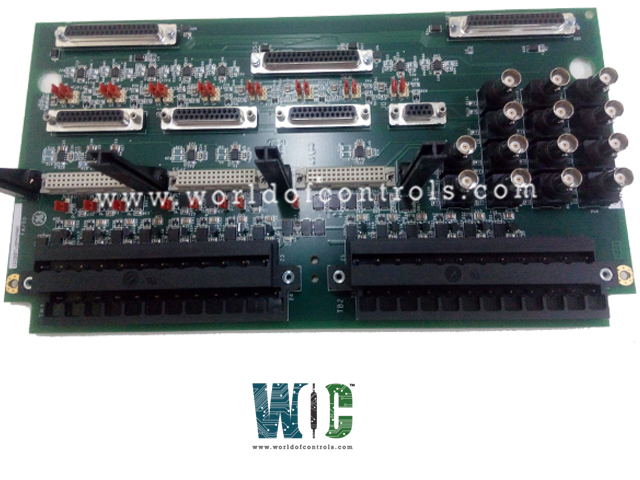
World Of Controls understands the criticality of your requirement and works towards reducing the lead time as much as possible.
IS200TVBAS1A - Vibration Terminal Board is available in stock which ships the same day.
IS200TVBAS1A - Vibration Terminal Board comes in UNUSED as well as REBUILT condition.
To avail our best deals for IS200TVBAS1A - Vibration Terminal Board, contact us and we will get back to you within 24 hours.
SPECIFICATIONS:
Part Number: IS200TVBAS1A
Manufacturer: General Electric
Series: Mark VI
Product Type: Vibration Terminal Board
Number of channels supporting vibration probes: 8
Number of channels with selectable pull: 8
Number of channels with PRxxL: 8
MPU pulse rate range: 2 Hz to 20 kHz
Voltage Range: 18 - 32 VDC
Number of buffered outputs: 14
Mounting: DIN-rail mounting
Amplitude accuracy: � 0.1%
Technology: Surface mount
Number of N24 outputs: 14
N24 maximum current: 12 mA
Operating temperature: -30 to 65�C
N28 voltage: 28 normal
N28 maximum current: 400 mA
Size: 33.0 cm high x 17.8 cm
Repair: 3-7 Days
Availability: In Stock
Country of Origin: United States
Manual: GEH-6721D
FUNCTIONAL DESCRIPTION:
IS200TVBAS1A is a Vibration Terminal Board manufactured and designed by General Electric as part of the Mark VI Series used in GE Speedtronic Gas Turbine Control Systems. The vibration terminal board (TVBA) acts as a signal interface board for the Mark VIe I/O pack PVIB. In the Mark VI system, the VVIB board works with TVIB. The TVBA provides a direct interface to seismic (velocity), Proximitors, Velomitors, and accelerometer-type probes. The terminal board provides signal suppression and electromagnetic interface (EMI) protection for each input signal. Signals are also connected to a pull-up bias to allow open circuit detection. The signals are passed on to the Mark VIe I/O packs through a 37-pin connector. The TVBA can be used for either simplex or TMR applications.
TMR applications fan the signal to three I/O packs. The TVBA contains buffered outputs to additional connectors beyond the standard 37-pin connection. This feature allows special 9 and 25-pin connectors to feed the Bently Nevada 3500 monitoring system. A bayonet nut connection (BNC) connection for each channel is also included with this feature, to feed other third-party monitoring equipment. Mark VIe systems do not use the traditional RKPS power supply. Power is obtained from sourced +28V power supplies, and there is no external source for -28V. The TVBA must maintain the same functionality as the Mark VI TVIB. For this reason, the TVBA will have three removable daughterboards to convert +28 to -28. These boards, WNPS (negative power supply), will be the source for all negative power used by the TVBA.
INSTALLATION:
The TVBA accepts 14 sensor inputs that are wired directly to two I/O terminal blocks. Each block is held down with two screws and has 24 terminals accepting up to #12 AWG wires. A shield termination attachment point is located adjacent to each terminal block.
Input Channels 1 through 8:
Input Channels 9 through 12:
Input Channel 13:
-28V power supply board, WNPS:
CONFIGURATION:
Jumper settings for TVBA are as follows:
Jumpers J1A through J8A:
Jumpers J1B through J8B:
Jumpers J1C through J8C:
WOC is proud to offer the largest inventory of OEM Replacement parts for GE Speedtronic Gas Turbine Control Systems, ensuring that our clients have immediate access to the components they need to keep their systems running smoothly. Beyond supplying new and refurbished boards, we specialize in repairing faulty units, applying rigorous testing and quality control to restore them to full operational performance, all backed by a comprehensive warranty. Our team of highly trained experts is available around the clock, providing technical guidance, troubleshooting support, and solutions tailored to the unique requirements of your automation systems. At WOC, we are committed to delivering not just parts, but complete support for the lifecycle of your control systems, helping you maximize uptime, reduce operational risks, and optimize performance. For inquiries regarding pricing, availability, or repair services, our team is ready to assist you promptly via phone or email.
What is a Vibration Terminal Board?
A Vibration Terminal Board is an interface board used to connect vibration sensors to a control system. It routes signals from multiple sensors and ensures accurate transmission to monitoring or diagnostic equipment. The board may also include on-board ID devices for system recognition and fault detection. It is commonly used in turbine, generator, or industrial machinery monitoring systems.
What types of sensors can be connected?
Typically, vibration terminal boards support piezoelectric, accelerometer, or velocity sensors. Each channel on the board can accommodate a specific sensor type based on the system design. Proper wiring and termination are critical to maintain signal accuracy and avoid noise interference.
How does the board handle faults or diagnostics?
The board includes diagnostic features that alert the control system if a sensor or connection fails. On-board ID chips allow the system to identify the board type, serial number, and revision, enabling precise troubleshooting. Faults are reported to the monitoring system to ensure timely maintenance and prevent equipment damage.
How is the board installed?
The vibration terminal board is mounted in a secure location near the sensors and control system. Connections are made via terminal blocks or connectors, with proper grounding to reduce interference. Installation should follow the manufacturer�s guidelines to ensure reliable signal transmission and system safety.